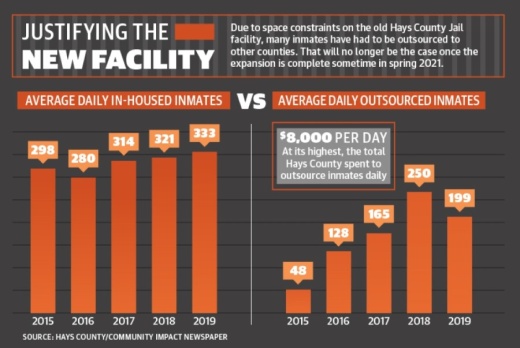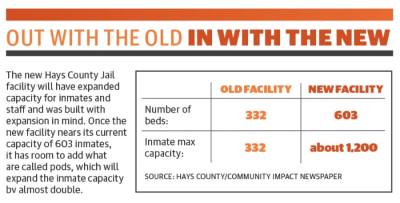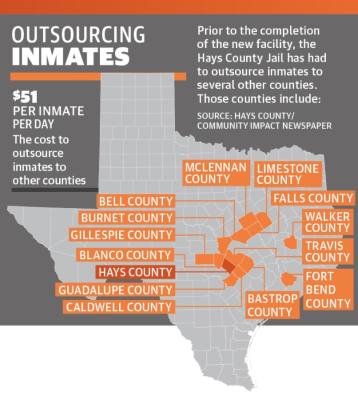The roughly $57.5 million expansion of the Hays County Jail facility is projected by county officials to be complete by spring 2021, and that will cap off a roughly five-year journey from voter-approved funding through a 2016 bond to the integration of all inmates.
While local officials maintain a jail is not looked at as a source of revenue for a county’s budget, the ongoing completion process of the Hays County Jail is emblematic of the adjustments needed for an area that has a rapidly growing population. For county officials, the project enables much needed flexibility through added capacity.
Sheriff Gary Cutler said crowded conditions have been an issue off and on at the county jail for two decades, and the addition of about 120,000 square feet as part of the jail overhaul brings several advantages for the county.
The expansion is coming as part of a $106.4 million bond package approved by voters in 2016 and includes an expanded kitchen, as well as laundry and medical facilities that are designed to accommodate a maximum capacity of about 1,200 inmates.
However, that population level is not anticipated to be reached for at least another 10-15 years, Cutler said.
Of great benefit to Hays County’s budget, Cutler said, when the entire project is complete and all inmates are being housed at the new facility, the county will no longer have to outsource inmates to other locations at a cost of about $51 per inmate per day.
Information from Hays County shows that has added up to a daily cost of several thousand dollars and a total cost of several million dollars since 2014. All tallied, financial data from Hays County shows the outsourcing of inmates has cost $16,278,820.35 since 2014.
“We have continued to outsource since 2014,” Cutler said. “We have not had a day where we didn’t outsource since then.”
The cost of outsourcing
When Cutler first took office in 2010, he said he was able to make some initial adjustments that curbed outsourcing, but by 2014 the original facility with its maximum capacity of a little over 300 could no longer handle the number of inmates coming in.
Because of this, some inmates have been housed outside Hays County through interlocal agreements with several other counties, including Caldwell County, Guadalupe County, Travis County and Limestone County, which is more than 160 miles away.
“We’ve kept these agreements, and we’ve had them with several other counties,” he said. “They work real well for us, and they’ll continue to do so until we get this building completed.”
Cutler said it is too soon to say when the county will begin to see savings brought about by the elimination of outsourcing because there is not yet a definitive time frame for integrating all inmates into the new facility.
Still, the potential for expenditure reduction looms large, especially given the daily expenses in outsourcing inmates alone for Hays County.
“We are spending ... roughly $8,000 a day [to outsource inmates],” Cutler said. “That would start going away as we start bringing inmates back.”
A facility designed to grow
Now more than 30 years old, the existing jail has been primed for expansion and renovation for several years, even decades, Cutler said.
The project’s construction company, Turner, shows the public safety bond program cost $106.4 million, and the most recent county cost estimates from late October show approximately $57.5 million of that money went for construction of the jail expansion.
That cost includes the jail addition, a training building, a fleet maintenance building and various renovations.
As it stands now, the expansion adds 121,600 square feet of space that will allow for additional inmate beds, segregation cell beds, infirmary beds and youth offender beds that Cutler said will help meet the projected growth.
Cutler said the facility’s main infrastructure that includes a kitchen, infirmary and laundry facility has been built to handle the addition of what are called pods. Pods can handle a certain number of additional inmates, he said, and the Hays County expansion includes extra land space to accommodate those pods when they are inevitably needed.
When fully expanded, Cutler said the maximum capacity for the facility will be about 1,200 inmates
“We are prepared for 2030, 2035 for population growth,” Cutler said. “Remember, the key is the common areas. All of that is structured and in place for max capacity. So all we would need to add is the housing.”
Accounting for growth is something the Texas Commission on Jail Standards emphasizes and strongly encourages, according to TCJS Executive Director Brandon Wood.
As one example, Wood said counties needing jail facility upgrades might make a 20-year plan for all of the support services it will need, and within that plan would be a consideration to construct another pod onto the existing facility at the 15-year mark to house an additional 150 inmates.
The TCJS recommends that counties plan their facility so they do not have to add anything for 20 years, and Wood said that now many jails are being designed so they can double in capacity.
“We placed a lot of emphasis on making sure counties do plan for future expansions,” Wood said. “That often entails ensuring that the support services and administrative logistical functions necessary to operate a jail are built in the beginning so that you are able to simply add additional beds in the future and not have to go through and completely redesign the jail.”
Work remains for the upgrade project
While both Cutler and Hays County Jail Administrator Capt. Julie Villalpondo said they estimate having all of the inmates ready to move into the new facility by spring 2021, there are still many phases yet to complete, including a state jail inspection, staffing and several more months of renovations for the project.
“In order to renovate, we have to remove those groups of inmates, move them into the new housing unit while we do all the renovations, and each phase of renovations can take three months,” Villalpondo said.
But beyond the task of moving all inmates into the new facility, the entire operation will need to a staff commensurate with the scope of the expansion.
When all positions are funded, possibly by the next fiscal year of 2021-22, Villalpondo said, the jail will have 162 correctional officers, 31 civilian specialists, 30 supervisors and 19 other administrative positions for a total staff of 242 employees.
Budget information from the Hays County 2021 personnel schedule shows officials have approved 12 new corrections officers at a cost of $548,223, but Villalpondo said the facility will still require another 22 corrections officers as well as seven more civilian staff in order to meet the needs of the new capacity.
“We have to put these new corrections officers through six weeks or 120 hours of jailers school as well, so it can take three or four months to finally get somebody ready to hit the floor,” she said. “So that is one of the challenges we have with this.”
A similar project in Comal County
While Hays County’s jail expansion is still several months from seeing the integration of all of its inmates and staff, Comal County is already done with its facility expansion.
After a roughly five-year journey from voter-approved funding in 2015 to the moving in of inmates in late September, the $76 million Comal County Jail expansion and sheriff’s office renovation project has already seen the integration of all of its inmates and has eliminated the need for outsourcing to other counties.
Documents from Comal County show the original jail was built in 1985 and underwent an expansion in 1999, but Comal County Jail administrator Maj. Bill Jennings said that only held for so long until local inmates were having to serve their terms in other counties.
Staff moved 276 inmates into the new facility from the old facility Sept. 23. The following day they moved in the remaining 39 inmates who had been outsourced to Atascosa County.
The new facility has a maximum capacity of 582, but Jennings pointed out the project was designed to expand through a pod system, just like in Hays County.
The facility can expand to house anywhere from 900-1,100 inmates, and Jennings said that allows the facility to add more beds without affecting its infrastructure.
Jennings and other county officials have said one of the major benefits brought about by the jail expansion comes from the fact that with the extra capacity, not only does the county not have to outsource its inmates anymore—at its most expensive Jennings said that was costing the county up to $5,000 per day—but now outside entities that include Hays County are looking to house their inmates at the new Comal County facility.
“It’s a little too soon to say if we’re going to do the interlocal agreements right now,” Jennings said. “I know the talk is there. Of course we want to help out our neighboring counties.”








